跨文化交际第二章文化与跨文化交际
- 格式:ppt
- 大小:3.80 MB
- 文档页数:28

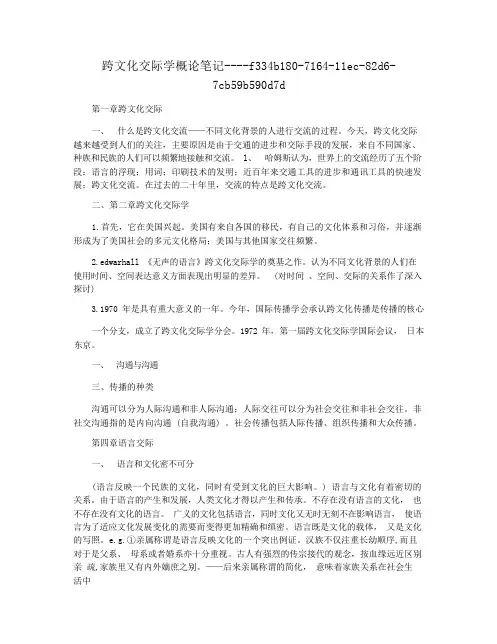
跨文化交际学概论笔记----f334b180-7164-11ec-82d6-7cb59b590d7d第一章跨文化交际一、什么是跨文化交流——不同文化背景的人进行交流的过程。
今天,跨文化交际越来越受到人们的关注,主要原因是由于交通的进步和交际手段的发展,来自不同国家、种族和民族的人们可以频繁地接触和交流。
l、哈姆斯认为,世界上的交流经历了五个阶段:语言的浮现;用词;印刷技术的发明;近百年来交通工具的进步和通讯工具的快速发展;跨文化交流。
在过去的二十年里,交流的特点是跨文化交流。
二、第二章跨文化交际学1.首先,它在美国兴起。
美国有来自各国的移民,有自己的文化体系和习俗,并逐渐形成为了美国社会的多元文化格局;美国与其他国家交往频繁。
2.edwarhall 《无声的语言》跨文化交际学的奠基之作。
认为不同文化背景的人们在使用时间、空间表达意义方面表现出明显的差异。
(对时间、空间、交际的关系作了深入探讨)3.1970 年是具有重大意义的一年。
今年,国际传播学会承认跨文化传播是传播的核心一个分支,成立了跨文化交际学分会。
1972 年,第一届跨文化交际学国际会议,日本东京。
一、沟通与沟通三、传播的种类沟通可以分为人际沟通和非人际沟通;人际交往可以分为社会交往和非社会交往。
非社交沟通指的是内向沟通 (自我沟通) 。
社会传播包括人际传播、组织传播和大众传播。
第四章语言交际一、语言和文化密不可分(语言反映一个民族的文化,同时有受到文化的巨大影响。
) 语言与文化有着密切的关系。
由于语言的产生和发展,人类文化才得以产生和传承。
不存在没有语言的文化,也不存在没有文化的语言。
广义的文化包括语言,同时文化又无时无刻不在影响语言,使语言为了适应文化发展变化的需要而变得更加精确和缜密。
语言既是文化的载体,又是文化的写照。
e.g.①亲属称谓是语言反映文化的一个突出例证。
汉族不仅注重长幼顺序,而且对于是父系、母系或者婚系亦十分重视。
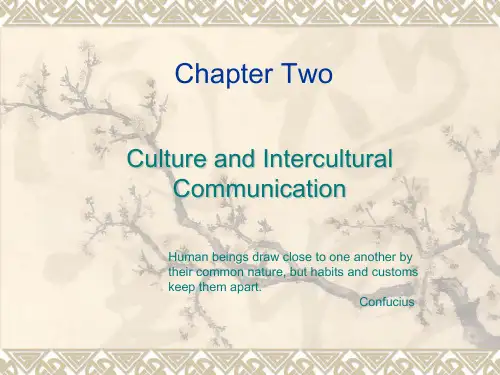
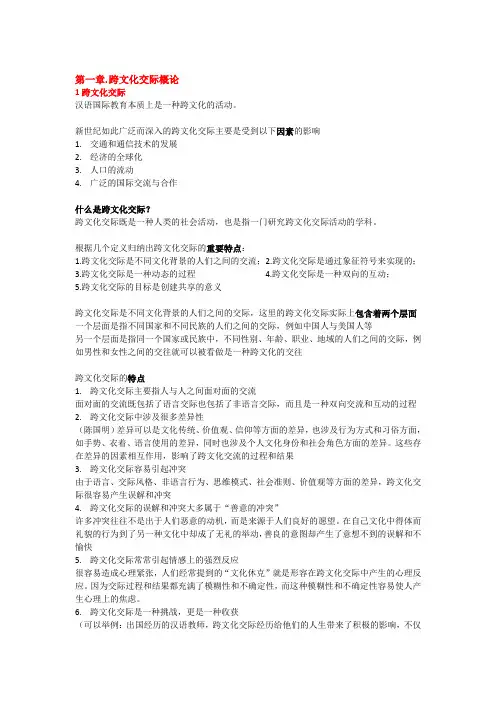
第一章.跨文化交际概论1跨文化交际汉语国际教育本质上是一种跨文化的活动。
新世纪如此广泛而深入的跨文化交际主要是受到以下因素的影响1.交通和通信技术的发展2.经济的全球化3.人口的流动4.广泛的国际交流与合作什么是跨文化交际?跨文化交际既是一种人类的社会活动,也是指一门研究跨文化交际活动的学科。
根据几个定义归纳出跨文化交际的重要特点:1.跨文化交际是不同文化背景的人们之间的交流;2.跨文化交际是通过象征符号来实现的;3.跨文化交际是一种动态的过程4.跨文化交际是一种双向的互动;5.跨文化交际的目标是创建共享的意义跨文化交际是不同文化背景的人们之间的交际,这里的跨文化交际实际上包含着两个层面一个层面是指不同国家和不同民族的人们之间的交际,例如中国人与美国人等另一个层面是指同一个国家或民族中,不同性别、年龄、职业、地域的人们之间的交际,例如男性和女性之间的交往就可以被看做是一种跨文化的交往跨文化交际的特点1.跨文化交际主要指人与人之间面对面的交流面对面的交流既包括了语言交际也包括了非语言交际,而且是一种双向交流和互动的过程2.跨文化交际中涉及很多差异性(陈国明)差异可以是文化传统、价值观、信仰等方面的差异,也涉及行为方式和习俗方面,如手势、衣着、语言使用的差异,同时也涉及个人文化身份和社会角色方面的差异。
这些存在差异的因素相互作用,影响了跨文化交流的过程和结果3.跨文化交际容易引起冲突由于语言、交际风格、非语言行为、思维模式、社会准则、价值观等方面的差异,跨文化交际很容易产生误解和冲突4.跨文化交际的误解和冲突大多属于“善意的冲突”许多冲突往往不是出于人们恶意的动机,而是来源于人们良好的愿望。
在自己文化中得体而礼貌的行为到了另一种文化中却成了无礼的举动,善良的意图却产生了意想不到的误解和不愉快5.跨文化交际常常引起情感上的强烈反应很容易造成心理紧张,人们经常提到的“文化休克”就是形容在跨文化交际中产生的心理反应。

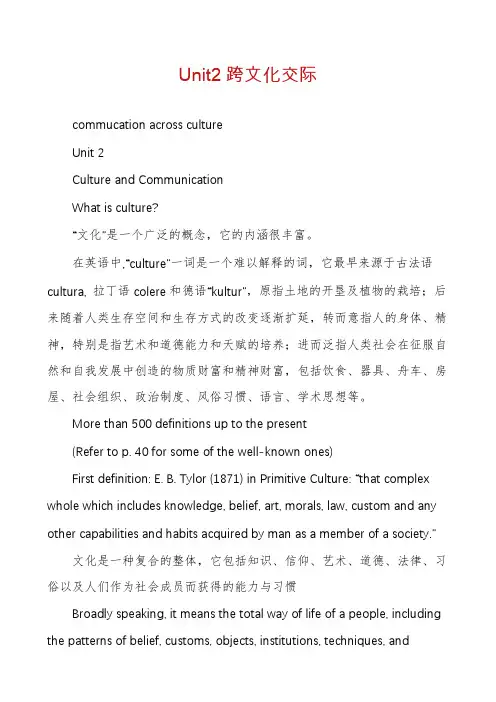
Unit2跨文化交际commucation across cultureUnit 2Culture and CommunicationWhat is culture?“文化”是一个广泛的概念,它的内涵很丰富。
在英语中,“culture”一词是一个难以解释的词,它最早来源于古法语cultura, 拉丁语colere和德语“kultur”,原指土地的开垦及植物的栽培;后来随着人类生存空间和生存方式的改变逐渐扩延,转而意指人的身体、精神,特别是指艺术和道德能力和天赋的培养;进而泛指人类社会在征服自然和自我发展中创造的物质财富和精神财富,包括饮食、器具、舟车、房屋、社会组织、政治制度、风俗习惯、语言、学术思想等。
More than 500 definitions up to the present(Refer to p. 40 for some of the well-known ones)First definition: E. B. Tylor (1871) in Primitive Culture: “that complex whole which includes knowledge, belief, art, morals, law, custom and any other capabilities and habits acquired by man as a mem ber of a society.”文化是一种复合的整体,它包括知识、信仰、艺术、道德、法律、习俗以及人们作为社会成员而获得的能力与习惯Broadly speaking, it means the total way of life of a people, including the patterns of belief, customs, objects, institutions, techniques, andlanguage.In a narrow sense, it refers to local or specific practice, beliefs or customs, and language. Define culture from different perspectives From Intellectual PerspectiveFrom Anthropologic PerspectiveFrom Social PerspectiveFrom Psychological PerspectiveFrom Intercultural Communication PerspectiveFrom Intellectual PerspectiveAccording to the Concise Oxford Dictionary, culture is “the arts and other manifestations of human intellectual achievement regarded collectively".It refers to intellectual perspective, such as music, art, exhibition, dance, etc. When you talk about Picasso, Beethoven, etc., you are talking about culture.From Anthropologic PerspectiveCulture is "the customs, civilizations, and achievements of a particular time or people." This is an anthropologist's definition.From Social PerspectiveCulture is what a society does and thinks.Culture covers everything of a society.From Psychological PerspectiveCulture is the collective programming of the mind which distinguishes the members of one category of people from another.From Intercultural Communication PerspectiveCulture is a learned set of shared interpretations about beliefs, values, and norms, which affect the behavior of a relatively large group of people.Culture Is LearnedWe learn culture from __parents__, ____teachers____ friends ___,_other familycommucation across culturemembers_____,_ and even strangers who are part of the culture_.Culture Is a Set of Shared InterpretationsAll communications take place by means of symbolsCulture Involves Beliefs, Values, and Normsa. BeliefsBeliefs refer to the basic understanding of a group of people about what the world is like or what is true or false.b. ValuesValues involve what a culture regarded as good or bad, right or wrong, fair or unfair, just or unjust, beautiful or ugly, clean or dirty, valuable or worthless, appropriate or inappropriate, and kind or cruel.c. NormsNorms refer to rules for appropriate behavior, which provide theexpectations people have of one another and of othersNorms in the army: SalutesNorms in different fields:Culture Affects BehaviorsCulture Involves Large Groups of PeopleThree Things Culture Doesp46-48 (self-study)Culture ranks what is importantCulture furnishes attitudesCulture dictates how to behaveCulture ranks what is importantDifferent cultures have their own value orientation and what is important in one culture may be virtually meaningless to another.Culture ranks what is important. In other words, cultures teach values or priorities.Values underlie attitudes. They also shape beliefs.Within a culture, values may be of greater or lesser importance.Culture furnishes attitudesAn attitude is learned, and it is a tendency to respond the same way to the same object or situation or idea.Attitudes can change, although change can be difficult. Attitudes are based on beliefs as well as values.Beliefs are convictions or certainties based on subjective and often personal ideas rather than on proof or facts. Belief systems or religions are powerful sources of values and attitudes in cultures.Culture dictates how to behaveBehavior comes directly from the attitudes about how significant something is --- how it is valued.Attitudes vary according to how important something is reckoned to be (value).Values drive actions.1.3 Classification of Culturecommucation across cultureOne of the most popular classification of culture:high culture: philosophy, literature, fine arts, music, religion etc.popular culture: customs and habits, rites and rituals, ways of living (housing, dressing, eating and drinking) and all interpersonal behavior.deep culture: the conception of beauty, definition of sin, notions of modesty, ordering of time, etc.Cultural iceberg: p. 44-50Conscious or subconscious?Deep culture―the out-of-awareness part of a cultureNine-tenth of an iceberg / culture is out of sight.Those that are above the “water” :what to eat and how to eat it;how to keep healthy;how to raise children;how to participate in ceremonies;how to introduce and greet people;Those that are below the “water” :what is good or bad;what is right or wrong;what is beautiful or ugly;what is clean or dirty;how is an individual related to others;Generally speaking, differences in those things that are usually outside of our consciousawareness, i.e. the so-called “ deep culture”, are more likely to cause problems in intercultural communication. The reason is that this part of culture is internalized in people’s mind and thus is hard to perceived.SummaryCulture is not anything that people in a group are born with, but something they learn either by being taught or by growing up in it.Different cultures have different ways of eating, drinking, dressing, finding shelter, marrying and dealing with death.Our own culture seems natural to us while other cultures may think itfunny, strange or even disgusting. However, this has nothing to do with right or wrong.It follows that there is no “best” culture suitable for all p eople in the world. In comparing cultures, we can hardly say which culture is definitely better than the other, for each culture can be appropriate to certain group of people living in a particular geographic and social environment.A culture should therefore be judged and interpreted in its own context. Without considering the environment in which people of a particular culture live, it would be impossible for us to really understand and appreciate what is significant and meaningful in that culture.Perhaps, if we could examine the manners of different nations with impartiality, we should find no people so rude, nor any so polite.2. Instinctive Behavior andCultural Behaviorcommucation across cultureReading : p. 41Questions:---Do you know Maslow’s theory?---Do human beings realize all these needs at the same time?---Do people all over the world share the same basic needs described by Maslow? ---Do people realize these needs in the same ways?---Is culture conscious or subconscious?2.1 Instinctive behavior―innate and universal2.2 Cultural behavior―learned and transmitted from generation to generation through the use of symbolsPeople in different cultures satisfy these needs in different ways.Examples:Different ways of eating p.43;Difference in treating visitors. p. 38 (Warm Up)Difference in ending the meals. p. 59 (Group Work)Case AnalysisCase 5 p. 60Difference in taking offersCase 7 p.62Difference in the view of giftsCase 8 p.62-63Difference in food for banquet, table mannersAnalysisIn China, it is often not polite to accept a first offer and Heping was being modest, polite and well-behaved and had every intention of accepting the beer at the second or third offer. But he did not know the North American rules which firmly say that you do not pull alcoholicbeverages on anyone. A person may not drink for religious reasons, he may be a reformed alcoholic, or he may be allergic.Whatever the reason, you do not insist on offering alcohol. So the Americans didn’t make a second offer of beer to Heping, who probably thought North Americans not hospitable. However, there are always individual differences between people from even the same culture. Probably the young Chinese nurse had known something about the American culture and was just trying to behave like an American when she was in an American family.Case 7 p.62What do you think of Keiko insisting on giving valuable gifts to her college friends?How would you feel if Keiko presented you with a gift for your help?AnalysisKeiko insists on giving valuable gifts to her college friends, because in countries like Japan, exchanging gifts is a strongly rooted social tradition. Should you receive a gift, and don’t have one to offer in return, you will probably create a crisis. If not as serious as a crisis, one who doesn’t offer a gift in return may be considered rude or impolite.Therefore, in Japan, gifts are a symbolic way to show appreciation, respect, gratitude and further relationship.commucation across cultureKeiko obviously has taken those used items from Mary, Ed and Marion as gifts, for sheprobably doesn’t know that Americans frequently do nate their used household items to church or to the community.Mary, Ed and Marion would never consider those used household items given to Keiko as gifts. No wonder they felt very uncomfortable when they received valuable gifts in return. Case 8 p.62-63Why did the girl consider the menu created by her mother a strange one?What cultural differences can you find in this case?AnalysisWhen the Chinese girl fell in love with an American boy at that time, it seems that shepreferred to celebrate Christmas in the American way, for she wanted very much to appear the same as other American girls. She did not like to see her boyfriend disappointed at the “shabby” Chinese Christmas. That’s why she cried when she found out her parents had invited the minister’s family over for the Christmas Eve dinner. She thought the menu for the Christmas meal created by her mother a strange one because there were no roast turkey and sweet potatoes but only Chinese food.How could she notice then the foods chosen by her mother were allher favorites?From this case, we can find a lot of differences between the Chinese and Western cultures in what is appropriate food for a banquet, what are good table manners, and how one should behave to be hospitable. However, one should never feel shame just because one’s culture is different from others’. As Amy’s mother told her, you must be proud to be different, and your only shame is to have shame.3.1 Definition of Communication---A behavior-affecting process in which one person (a source) intentionally encodes andtransmits a message through a channel to an intended audience (receivers) in order to induce a particular attitude or behavior.---Transmission and reception of meaning through the manipulation of symbols, language and context.---A process involving the exchange of messages and the creation of meaning.(p.58)It involves a sender who encodes a message and a receiver who decodes the message.3.3 Types of Communication(1)Interpersonal Communication (Dyad)Intrapersonal Communication (Within)Mass CommunicationGroup CommunicationPublic CommunicationBusiness CommunicationIntracultural CommunicationShared communication between members of the same cultural group /communication between people from the same culturecommucation across cultureIntercultural Communicationcommunication between people from different culturesIntercultural Communication…Requires an understand ing of …Own cultureCultures of other groupsParent/Dominant culture (e.g. based on race or ethnicity)Co-cultures (e.g. based on gender, religion, age)Intercultural Communication…Requires an understanding of …..Knowledge systemBeliefsValuesCustomsBehaviorsIntercultural / Cross-cultural CommunicationAlthough the term cross-cultural is often used as a synonym for intercultural, it traditionally implies a comparison of some phenomena across cultures.For example, if we examine communication between two Chinese or between two Americans, we are looking at intra-cultural communication.If we observe communication between a Chinese and an American, in contrast, we are looking at intercultural communication.If we compare the speech act of apology in the Chinese culture and in the American culture, for example, we are making a cross-cultural comparison.If we look at how an American or a Chinese is making an apology when communicating with each other, in contrast, we are looking at intercultural communication.Cross-Cultural CommunicationInvolves highlighting similarities and differences across cultural groups to promotecommunicationInternational CommunicationInteractions among people from different nations. Certainly, communication among people from different countries is likely to be intercultural communication, but that is not always true.3.3 Types of Communication(2)human communication (人类交际)animal communication (动物交际)human-animal communication (人类与动物的交际)human-machine communication(人机交际)machine-to-machine communication(机器交际)3.4 Media of CommunicationFace-to-FaceTelephoneBroadcast MediaVerbalNon-verbalcommucation across cultureWhich other media of communication can you identify?3.6 The Communication ProcessMatching Task p.57One more example:1. A: Can you tell me the time?B: Well, the milkman has come.(No, I don’t know the exact time, but I can tell you that the milkman has come so that you may be able to tell what the approximate time it is now.)Case 6 p.61 ( assignment)Case AnalysisCase 6 p.61Why did the Chinese mother-in-law decide to leave the very afternoon?What was wrong with Litz asking her husband how long his mother was going to stay just two days after her mother-in-law’s arrival?AnalysisWhen a speaker says something to a hearer, there are at least three kinds of meanings invol ved: utterance meaning, the speaker’s meaning and the hearer’s meaning.In the dialogue, when Litz asked how long her mother-in-law was going to stay, she meant that if she knew how long she was going to stay in Finland, she would be able to make proper arrangements for her, such as taking her out to do some sightseeing. However, hermother-in-law took Litz’s question to mean “ Litz does not want me to stay for long”. From the Chinese point of view, it seems inappropriate for Litz to ask such a question just two days after her mother-in-law’s arrival. If she has to ask the question, it would be better to ask some time later and she should not let her mother-in-law hear it.Another CaseSituation:A Chinese student had just arrived at the States. One day, when he was reading in his room, he heard someone shouting outside: “ Watch out!” So he went to the window and stretched out his head and tried to find out what’s going on outside. Just then, his head was right poured by the water from abo ve…Question:What are the three meanings of “ Watch out” in communication?Key to the question:1. Utterance meaning: Be careful!2. Speaker’s meaning: Don’t pull out !3. Hearer’s meaning:Something is happening! Look out!3.9 Characteristics of Communication p.68-73DynamicSymbolicInteractiveInterpretiveContextualcommucation across cultureCommunication is a dynamic processCommunication is an ongoing, ever changing activity. It is not fixed.“You can’t stand in the same stream twice.”When people communicate, they are constantly affected by each other’s messages and as a consequence, people undergo continual change.Each time one is influenced, one changes in some way and people never stay frozen when in communication.Once a word or an action is employed, it cannot be retracted.Communication is symbolicCommunication involves the use of symbols.A symbol is a word, action, or object that strands for or presents a unit of meanings. Meaning, in turn, is a perception, thought, or feeling that a person experiences and might want to communicate to others.People’s behaviors are frequently interpreted symbolically, as an external representation of feelings, emotions, and internal states.Communication is interactive/transactionalCommunication must take place between people.When two or more people communicate, their unique backgrounds and experiences serve as a backdrop for the communication interaction.Communicators are simultaneously sending and receiving messages at every instant that they are involved in conversations.There are no such entities as pure senders or pure receivers.Communication is systemic/contextualCommunication does not occur in isolation or in a vacuum, but ratheris part of a larger system.Setting and environment help determine the words and actions you generate and the meanings you give the symbols produced by other people.Dress, language, topic selection, and the like are all adapted to context.People do not act the same way in every environment.Communication is contextual/systemicAll communication takes place within a setting or situation called a context.By context, we mean the place where people meet, the social purpose for being together, and the nature of the relationship.Thus, the context includes the physical, social, and interpersonal settings within which messages are exchanged.The physical context includes the actual location of the interactants: indoors or outdoors, crowded or quiet, public or private, close together or far apart, warm or cold, bright or dark. The social context refers to the widely shared expectations people have about the kinds of interactions that normally should occur given different kinds of social events.The interpersonal context refers to the expectations about the behaviors of others as a result of differences in the relationships between them. (examples---p69-70)commucation across cultureCommunication is interpretiveWhenever people communicate, they must interpret the symbolic behaviors of others and assign significance to some of those behaviors in order to create a meaningful account of the other’s actions.There is no direct mind-to-mind contact between people, you cannot access the thoughts and feelings of other human beings but can only infer what they are experiencing.Communication is complexAlthough all cultures use symbols to share their realities, the specific realities and the symbols employed are often quite different.People are both alike and different.Cultural, as well as individual, differences keep people apart.Members of different cultures look differently at the world around them.A successful intercultural communicator appreciates similarities and accepts differences.4. Elements of Communication p.50-56ContextParticipantsMessagesChannelsNoiseFeedbackphysical settingthe formality of the conference roomthe seating arrangementslightingthe time of daythe distance between communicatorshistorical contextprevious communication eventspsychological contextthe manner of perceiving themselves and otherscultural contextcommunication normsplay the roles of senders and receivers:senders form messagesC encoders;receivers process the messages and react to them―decoders variables affecting participants:---relationships: familiar or unfamiliar---gender: males or females---culture: from the same culture or from different cultures meaningscommucation across culturethe meanings may not be transferred successfullysymbolswords chosenfacial expressions, gesturestone of voiceencoding and decodingmessage encoded may not be decoded as intendedculture and nonverbal factors---sound, sight, smell, taste, touch---the nature of the channel selected affects the way a message will be processed---the impact of a message changes as the channel used to transmit it changes---the more channels used, the more successful the communication will be---any stimulus that interferes with the sharing of meaningexternal noisestimuli in the surrounding that distract attentioninternal noiseinterfering thoughts and feelings inside a communicatorsemantic noiseinappropriate choice of words---noise can function as a communication barrierverbal responsenonverbal responseserves useful functions for both senders and receivers: it provides senders with the opportunity to measure how they are coming across, and it provides receivers with the opportunity to exert some influence over the communication process.C-- cultural variables that undermine the communication of intended meaningExamples of Semantic Noise一次性用品:A Time Sex Thing一次性筷子:One Sex Chopsticks平时禁止入内:No entry on peace time小心溺水:Careful Drowning童子鸡:Chicken without sexual life麻婆豆腐:Bean curd made by a pockmarked woman贵阳:Expensive Sun干果区:Fuck the fruit areaAssignments1. Find a misleading sign in Meizhou and point out what’s wrong and give a correct one.2. Further Reading I : Understanding Culture p.64-67。
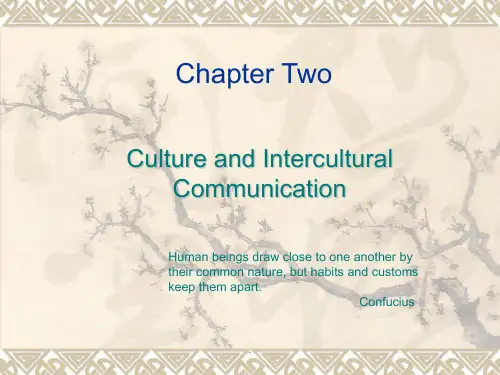


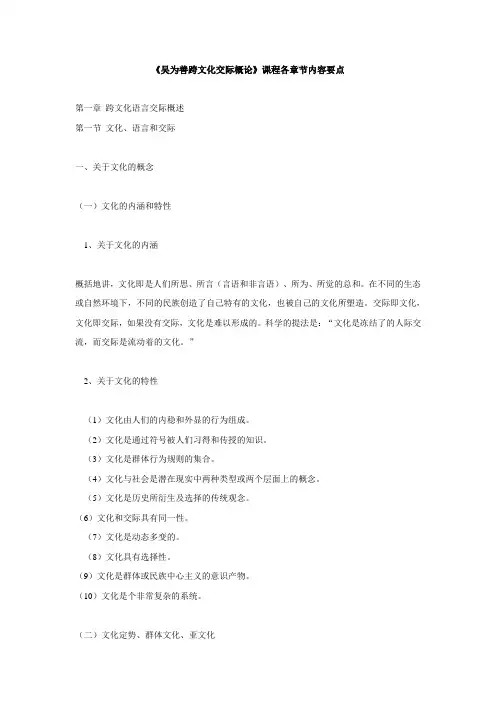
《吴为善跨文化交际概论》课程各章节内容要点第一章跨文化语言交际概述第一节文化、语言和交际一、关于文化的概念(一)文化的内涵和特性1、关于文化的内涵概括地讲,文化即是人们所思、所言(言语和非言语)、所为、所觉的总和。
在不同的生态或自然环境下,不同的民族创造了自己特有的文化,也被自己的文化所塑造。
交际即文化,文化即交际,如果没有交际,文化是难以形成的。
科学的提法是:“文化是冻结了的人际交流,而交际是流动着的文化。
”2、关于文化的特性(1)文化由人们的内稳和外显的行为组成。
(2)文化是通过符号被人们习得和传授的知识。
(3)文化是群体行为规则的集合。
(4)文化与社会是潜在现实中两种类型或两个层面上的概念。
(5)文化是历史所衍生及选择的传统观念。
(6)文化和交际具有同一性。
(7)文化是动态多变的。
(8)文化具有选择性。
(9)文化是群体或民族中心主义的意识产物。
(10)文化是个非常复杂的系统。
(二)文化定势、群体文化、亚文化1、文化定势和群体文化世界上大多数社会中都可能存在着若干群体或社团,这些群体或社团对地域、历史、生活方式、世界观,以及价值观等方面的共享,使其成员形成并发展和强化了自己独特的文化和与其相关的交际文化。
存在两种不同类型的文化范畴:一是全民族的文化,即整体的文化形象,二是具体的个性文化,即是按个人的社会情况或个人所属文化群体为基础的文化,有的学者把这种文化称之为群体文化或副文化。
2、亚文化与亚群体在跨文化交际研究中,对文化分类的一种较为传统的做法是把文化分成主流文化和亚文化。
亚文化是指存在于某一主流文化之中的一种非主流文化,某一少数群体的文化,这一文化中的行为模式区别于主流文化的行为模式。
二、关于语言的概念(一)语言是交际工具1、交际媒介言语交际是人类社会中必需的另一种交换活动,交换的是信息、思想、情感。
语言就是一个符号系统,一个人脑子里贮存了符号和符号的组合规则,他就可以和别人交际,传情达意,沟通信息。
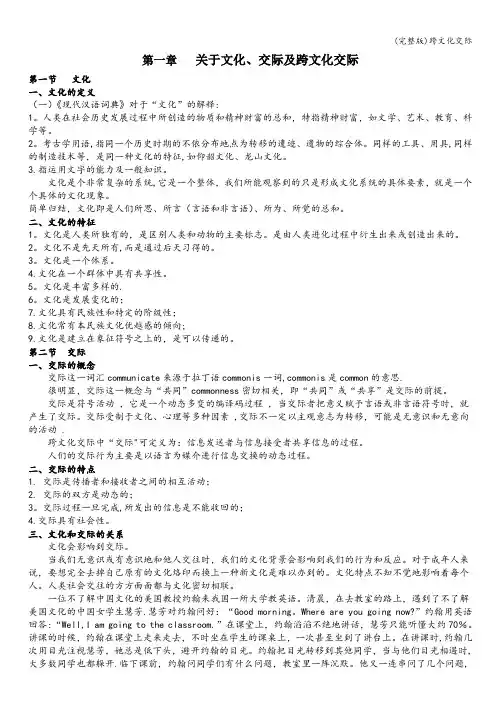
第一章关于文化、交际及跨文化交际第一节文化一、文化的定义(一)《现代汉语词典》对于“文化”的解释:1。
人类在社会历史发展过程中所创造的物质和精神财富的总和,特指精神财富,如文学、艺术、教育、科学等。
2。
考古学用语,指同一个历史时期的不依分布地点为转移的遗迹、遗物的综合体。
同样的工具、用具,同样的制造技术等,是同一种文化的特征,如仰韶文化、龙山文化。
3.指运用文字的能力及一般知识。
文化是个非常复杂的系统,它是一个整体,我们所能观察到的只是形成文化系统的具体要素,就是一个个具体的文化现象。
简单归结,文化即是人们所思、所言(言语和非言语)、所为、所觉的总和。
二、文化的特征1。
文化是人类所独有的,是区别人类和动物的主要标志。
是由人类进化过程中衍生出来或创造出来的。
2。
文化不是先天所有,而是通过后天习得的。
3。
文化是一个体系。
4.文化在一个群体中具有共享性。
5。
文化是丰富多样的.6。
文化是发展变化的;7.文化具有民族性和特定的阶级性;8.文化常有本民族文化优越感的倾向;9.文化是建立在象征符号之上的,是可以传递的。
第二节交际一、交际的概念交际这一词汇communicate来源于拉丁语commonis一词,commonis是common的意思.很明显,交际这一概念与“共同”commonness密切相关,即“共同”或“共享”是交际的前提。
交际是符号活动,它是一个动态多变的编译码过程,当交际者把意义赋予言语或非言语符号时,就产生了交际。
交际受制于文化、心理等多种因素 ,交际不一定以主观意志为转移,可能是无意识和无意向的活动 .跨文化交际中“交际"可定义为:信息发送者与信息接受者共享信息的过程。
人们的交际行为主要是以语言为媒介进行信息交换的动态过程。
二、交际的特点1. 交际是传播者和接收者之间的相互活动;2. 交际的双方是动态的;3。
交际过程一旦完成,所发出的信息是不能收回的;4.交际具有社会性。
三、文化和交际的关系文化会影响到交际。
第一部分绪论:跨文化交际与跨文化交际学第一章跨文化交际一、什么是跨文化交际——具有不同文化背景的人从事交际的过程跨文化交际之所以在今天日益引起人们的注意,主要原因是由于交通工具的进步与通讯手段的发展,使得不同国家、不同种族、不同民族的人能够频繁地接触和交往。
跨文化交际成为我们时代的一个突出特征。
L.S.Harms认为,在世界范围内的交际经历了五个阶段:语言的产生;文字的使用;印刷技术的发明;近百年交通工具的进步和通讯手段的迅速发展;跨文化交际。
近二十年来的交际是以跨文化为特征的。
二、对跨文化交际的不同理解有的人认为每个人在文化上都是独特的,所以任何两个人之间的交际都是跨文化交际。
有的人认为,不同国籍人们之间的文化差异与不同职业的人们之间的文化差异并没有什么本质上的区别,只是程度上的差异。
有的人认为,跨文化交际研究应该把重点放在亚文化系统的语篇系统方面。
有的人认为,作大范围的国与国之间的对比对于改进跨文化交际益处不大,应该把眼光放在更具体的文化差异上。
跨文化交际研究的范围应该也包括地区、职业、年龄、性别等方面的文化差异的探讨。
文化通常不是指个人的行为,而是指一个群体的生活方式和习惯。
作者认为作跨国、跨种族、跨民族研究不仅应该是跨文化交际研究包括的内容,而且应该是放在首位的。
至于地区、阶级、阶层、职业、性别、年龄等不同层次的差异也应该给予关注。
至于个人之间的差异的研究只是在我们把他们当做群体的代表时才有意义。
在研究一个国家的文化特点时,我们的眼光首先应集中在它的主流文化上,其次才注意它的亚文化和地区文化的特点。
第二章跨文化交际学一、跨文化交际学在美国Intercultural Communication 与人类学、心理学、传播学关系密切1.首先在美国兴起。
美国有来自各个国家的移民,有各自的文化系统和风俗习惯,逐渐在美国社会形成了多元文化的格局;美国与各国交往频繁。
2.Edwar Hall 《无声的语言》跨文化交际学的奠基之作。
第一部分绪论:跨文化交际与跨文化交际学第一章跨文化交际一、什么就是跨文化交际——具有不同文化背景的人从事交际的过程跨文化交际之所以在今天日益引起人们的注意, 主要原因就是由于交通工具的进步与通讯手段的发展,使得不同国家、不同种族、不同民族的人能够频繁地接触与交往。
L、S、Harms 认为,在世界范围内的交际经历了五个阶段:语言的产生;文字的使用;印刷技术的发明;近百年交通工具的进步与通讯手段的迅速发展;跨文化交际。
近二十年来的交际就是以跨文化为特征的。
二、对跨文化交际的不同理解:有的人认为每个人在文化上都就是独特的,所以任何两个人之间的交际都就是跨文化交际。
有的人认为, 不同国籍人们之间的文化差异与不同职业的人们之间的文化差异并没有什么本质上的区别,只就是程度上的差异。
有的人认为,跨文化交际研究应该把重点放在亚文化系统的语篇系统方面。
有的人认为,作大范围的国与国之间的对比对于改进跨文化交际益处不大,应该把眼光放在更具体的文化差异上。
跨文化交际研究的范围应该也包括地区、职业、年龄、性别等方面的文化差异的探讨。
文化通常不就是指个人的行为, 而就是指一个群体的生活方式与习惯。
作者认为作跨国、跨种族、跨民族研究不仅应该就是跨文化交际研究包括的内容,而且应该就是放在首位的。
至于地区、阶级、阶层、职业、性别、年龄等不同层次的差异也应该给予关注。
至于个人之间的差异的研究只就是在我们把她们当做群体的代表时才有意义。
在研究一个国家的文化特点时, 我们的眼光首先应集中在它的主流文化主流文化上,其次才注意它的亚文化与地区文化的特点。
主流文化-主流文化-亚文化-地区文化-小群体文化(不同年龄、职业、性别群体的文化)三、第二章跨文化交际学跨文化交际学在美国Intercultural Communication (与人类学、心理学、传播学关系密切)1、首先在美国兴起。
美国有来自各个国家的移民,有各自的文化系统与风俗习惯,逐渐在美国社会形成了多元文化的格局;美国与各国交往频繁。